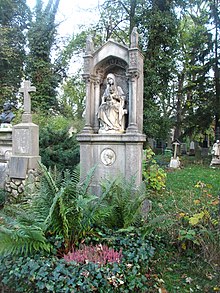Heinrich Maria von Hess
Heinrich Maria Hess , from 1844 Ritter von Hess (born April 19, 1798 in Düsseldorf , † March 29, 1863 in Munich ), was a German painter .
Life
Hess was a son of the engraver Carl Ernst Christoph Hess and the brother of the painter Peter von Hess . Hess received his first artistic lessons from his father. In 1806 he came to Munich with his family. At the age of 15, Hess attended the Academy of Fine Arts there in 1813 . Among his first works was a representation of the Holy Family , which was acquired by Queen Caroline .
Until 1821, Hess created a number of commissioned works for his patron , including several pictures of the Madonna. In 1821 Hess went on a study trip to Italy , especially to Rome , to study the ancient masters there. In 1826 he returned to Germany and settled again in Munich. There he painted the fresco Daphne in the arms of Apollo in the Glyptothek's hall of gods, based on a design by Peter Cornelius . At the request of the Bavarian King Ludwig I , Hess was appointed professor at the Munich Royal Academy of Fine Arts . At the I. King Ludwig founded the Royal Stained Glass Manufactory he designed from December 1826 for the Regensburg Cathedral stained glass; They were congenially executed by A. Frank and F. Schwarz, among others. They should revolutionize stained glass . Subsequently, Hess designed the glass paintings for the Mariahilfkirche in Au (Munich) . In 1837, Hess succeeded Friedrich Gärtner as the artistic director ("artistic inspector") of this institution.
In the spring of 1827, Hess held his inaugural lecture at the academy and opened a master class for oil painting . His first major work from the summer of 1827 was the decoration of the All Saints Court Church with frescoes in the neo-Byzantine style; after ten years he was able to complete this work in 1837 and present it to the public. In the first dome and its secondary vaults there were 33 smaller and larger representations from the Old Testament ; in the second dome and its secondary vaults 34 paintings from the New Testament . The apse showed eleven pictures from the history of the church.
Afterwards Hess worked in the basilica of the Abbey of St. Boniface (Munich) , where he described the life of St. Boniface in several frescoes and pictures. He illustrated the refectory with a depiction of the Lord's Supper . This work was completed in 1846 and handed over to its destination with a festive service. In between, from 1841 to 1843, Hess made the famous stained glass window of the Risen Christ for St. Isaac's Cathedral in St. Petersburg .
In 1844 Hess received the personal crown needle ("Knight's Cross of the Order of Merit of the Bavarian Crown ") and received permission from King Ludwig I to found another painting school, but was not financially supported by the Bavarian court - as originally promised. So Hess was only able to bring this institution into being three years later and almost entirely at his own expense. Mainly economic problems forced Hess to give up this project again after a short time.
With effect from April 1, 1848, Hess was appointed acting director of the Royal Academy of Fine Arts and then director of the "United State Collections". He was also an appraiser for the foundation of the Neue Pinakothek . In 1860 he was one of the founding members of the Munich Association for Christian Art . In 1862 Hess was accepted as a foreign member of the Académie des Beaux-Arts .
Heinrich Maria von Hess died on March 29, 1863 in Munich three weeks before his 65th birthday. His bust was displayed in the Hall of Fame in Munich. The grave of Hess is in the old southern cemetery in Munich (grave field 40 - row 12 - place 7/8). Location
Works (selection)

- Apollo and the Muses (1826)
- Caritas (approx. 1816-1820)
- Christmas Eve (approx. 1816-1820)
- Entombment of Christ (1817)
- Love, Faith, Hope (1819)
- Holy Family (1816)
- Portrait of the Marchesa Marianna Florenzi (1824)
literature
- Gottlieb Heinrich von Schröter : The fresco paintings of the All Saints Chapel in Munich , literary-artistic establishment, 1836 ( digitized ).
- Friedrich Pecht : Hess, Heinrich von . In: Allgemeine Deutsche Biographie (ADB). Volume 12, Duncker & Humblot, Leipzig 1880, pp. 278-281.
- Heinrich Schmidt: Hess, Heinrich von. In: New German Biography (NDB). Volume 9, Duncker & Humblot, Berlin 1972, ISBN 3-428-00190-7 , p. 3 ( digitized version ).
- Association for Christian Art in Munich (Hrsg.): Festgabe in memory of the 50th. Anniversary . Lentner'sche Hofbuchhandlung, Munich 1910, p. 81f.
Web links
- Heinrich Maria von Hess . In: LVR Institute for Regional Studies and Regional History
- Selection of paintings by Heinrich Maria von Hess . In: The-Athenaeum.org
References and comments
-
↑
The frescoes were destroyed in the bombing of April 25, 1944 and were not restored after the Second World War . See.
- Hermann Neumann: The Munich Residence (= Prestel Museum Guide ). Prestel, Munich 2000, ISBN 3-7913-2207-9 , pp. 25 and 89 .
- Bavarian Administration of State Palaces, Gardens and Lakes (Ed.): Allerheiligen-Hofkirche in the Munich Residence reopened . Press release. Munich June 3, 2003 ( RTF file 661 kB [accessed April 9, 2012]).
- ↑ Apollo and the Muses. pinakothek.de, accessed on October 11, 2017 .
| personal data | |
|---|---|
| SURNAME | Hess, Heinrich Maria von |
| ALTERNATIVE NAMES | Hess, Heinrich Maria Ritter von (full name); Hess, Heinrich |
| BRIEF DESCRIPTION | German painter |
| DATE OF BIRTH | April 19, 1798 |
| PLACE OF BIRTH | Dusseldorf |
| DATE OF DEATH | March 29, 1863 |
| Place of death | Munich |

